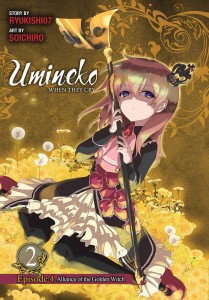Story by Ryukishi07; Art by Soichiro. Released in Japan in two separate volumes as “Umineko no Naku Koro ni: Alliance of the Golden Witch” by Square Enix, serialized in the magazine Gangan Online. Released in North America by Yen Press.
This review is a couple of months late, partly as so many others things came out at the same time, but mostly as this particular Umineko arc is so hard to read. Like Higurashi’s third arc, the Curse Killing Chapter, this arc deals extensively with abuse, particularly child abuse. Ange is bullied at school to the point where she wishes out loud for death, and the “magic” that she was once able to manipulate is lost to pure despair. Likewise, Maria can’t simply paper over her relationship with Rosa anymore, and when her mother goes too far, Maria’s wellspring of rage threatens to overwhelm the entire book.
One of the key features in Umineko is ridiculous over-the-top melodrama, and for the most part it’s been well-balanced between ridiculous light-heartedness and Grand Guignol awful violence. This volume, though, like the previous one, alters the original visual novel’s structure. The first omnibus was almost all Ange, with Battler and Beatrice relegated to the very end. Here it’s Ange’s struggles in 1998 that are missing – you’d be forgiven for thinking that she had genuinely been transported to Battler’s game, as we see nothing of her search with Amakusa to find the truth of what happened 12 years earlier. While I realize that these manga are done with the approval and supervision of Ryukishi07 (though not as much as the heavily rewritten 7th and 8th arcs), I wish that they’d kept the timeline of the original work.
Thematically we get more examination of what Magic is and how it can help you… and when it can’t. One of the most important scenes in the book is when Ange, tormented by the constant bullying she gets at school, orders the Stakes to kill all her classmates. It’s up to Mammon to state the obvious – they can’t do it as Ange is unable to commit murder. Magic may be able to hide actions in some other guise, but the responsibility remains with whoever uses it. And this shatters Ange, whose struggle to avoid crushing sadness and loathing is lost here. Likewise, once Maria faces the severed head of Sakutarou, ripped apart by Rosa in one of her angry rages (speaking of which, I wish we had a better look at Maria seeing it as a human severed head Rosa is holding up – censorship, I suspect, but another lost opportunity), there’s nothing left for her but dark magic, the magic of murdering people. And the fact that she kills her mother over and over again in the magical world shows she has the killing intent Ange doesn’t.
The other very important scene here is the one between Ange and Lambdadelta. Lambda has been shown to be cruel when it serves her purpose, and she’s incredibly cruel to Ange here, but she’s also trying to tell her the truth, which Bernkastel is avoiding in order to make Ange the perfect pawn. Nothing Ange does here can affect her own future. This isn’t Higurashi, where everything snaps back each time. Even if Ange somehow arranges it so no one dies in 1986, the her of 1998 can’t go back. This Ange is essentially doomed, something Lambda gleefully points out, before offering her own deal – keep the game going forever, with no winner or loser. It’s a sign of how much Ange has lost that she’s sorely tempted.
Of course, there’s also the problem of October 4th, and Beatrice’s game. We get a new Truth introduced here, the Blue Truth (again, colored ink is expensive, so have a different font). It allows the game to move faster, but I suspect won’t end well for Beatrice. We also get more sacrifices, and a focus on George and Jessica, who have to fight to prove they can be family head, and also for their loved ones. (For those who were expecting a focus on Kyrie, while she does get more attention here, there isn’t nearly as much as there was on the other three mothers in the first three arcs. It’s almost suspicious…) Of course, this whole volume is devoted to cruel reality. And thus, we do not end with Jessica and George being awesome, but rather with their sudden death.
We’ve got one more omnibus to go (well, for this arc – fear not, End is solicited), and at this point it’s all up to Battler. He’s been given a lot of help, things have been made more obvious, but does he really have the desire to win? And does he know what winning will cost him? As for this manga adaptation, I’ve mentioned my reservations with this adaptation, but that’s mostly as I’ve read the visual novel. For new readers, they may not notice. In the end, this is a hard arc to read, but it’s essential to understand what’s going on.
(One last whine: the manga left out the ridiculous parody fight between Krauss and the Goat. I may never forgive it for that.)


It’s really interesting comparing this manga adaption to the VN. I feel like the “ridiculous over-the-top melodrama” is even more pumped up here. The scene where Ange warns the bullies not to touch her hair accessories felt like a something right of “Carrie.” I had to stop and say, “Wait, did that happen in the VN?” And the classic “Sakutarou is dead” scene is even more cruel; I never imagined Rosa literally rubbing it in Maria’s face. I mean, damn.